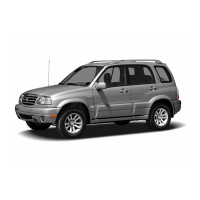
Do you have a question about the Suzuki 2010 Grand Vitara and is the answer not in the manual?
| Brand | Suzuki |
|---|---|
| Model | 2010 Grand Vitara |
| Category | Automobile |
| Language | English |
Details on the recommended fuel type and octane rating for optimal engine performance.
Information on the recommended engine oil viscosity and API service classification.
Specifies the type of brake and clutch fluid required for proper system function.
Identifies the recommended fluid for the automatic transmission system.
Highlights Suzuki's commitment to environmental conservation and recycling practices.
Provides guidance on how to address issues and contact Suzuki service support.
Explains the manual's goal: safe, enjoyable, and trouble-free vehicle experience.
Recommends reviewing warranty booklets for details on vehicle warranties.
Recommends visiting a local Suzuki dealership for regular scheduled maintenance.
Illustrates and lists key service points like fuel, engine, fluids, and tires.
Details on vehicle keys, ignition switch, and operation of door locking systems.
Instructions for operating power windows and adjusting power mirrors.
Guidance on adjusting front and rear seats and head restraints for safety.
Explains proper seat belt usage, child restraints, and pretensioner systems.
Details on front, side, and curtain air bags, including their operation and safety.
Provides precautions to prevent carbon monoxide poisoning from exhaust gases.
Checklist for essential vehicle components before driving.
Explains the functions of the ignition switch positions and keyless start system.
Step-by-step guide for starting the engine, including cold and warm starts.
Details on operating manual and automatic transmissions, including gear selection.
Instructions for operating the 4WD system's transfer switch modes.
Guide to setting, changing, and canceling cruise control speeds.
Explains power-assisted brakes, brake assist, and anti-lock brake system (ABS).
Details on ESP, Stability Control, and Traction Control system functions.
Information on the TPMS, low tire pressure warning light, and malfunction indicator.
Highlights unique handling characteristics like higher ground clearance and center of gravity.
Precautions for the first 960 km (600 miles) of vehicle operation for engine reliability.
Provides instructions to optimize fuel efficiency, such as avoiding excessive idling.
Guidance on reducing rollover risk by avoiding sharp turns and controlling slides.
Tips for driving on various off-road surfaces, including inclines and slippery conditions.
Details on operating the automatic heating, air conditioning, and air outlet controls.
Covers power, volume, tuning, bass/treble, and AVC controls for the audio system.
Explains MP3/WMA formats, file creation, and recording guidelines for CD media.
Instructions for tuning XM radio, selecting categories, and using preset memory.
Details on connecting and listening to external audio devices via the AUX input.
Guide to setting, canceling, and confirming the personal identification number (PIN).
Instructions for removing, stowing, and reinstalling the luggage compartment cover.
Information on using roof rails and anchors to attach an optional roof rack.
Steps for programming HomeLink® buttons to operate garage doors or other devices.
Explains weight capacities like GVWR, GAWR, and how to determine correct load limits.
Covers trailer hitch requirements, safety chains, and trailer light operation.
Details on gross trailer weight, combined weight, and tongue weight limits.
Specifies proper towing methods for 2WD and 4WD vehicles with or without transfer switch.
Provides an introduction to the maintenance schedule and recommendations.
Detailed table showing intervals for inspecting, replacing, or servicing vehicle components.
Instructions for inspecting the accessory drive belt for damage.
Guidance on checking engine oil level and replacing the engine oil and filter.
Procedures for checking engine coolant level and replacing coolant.
Covers tire sidewall labeling, inflation pressure, inspection, and rotation.
Instructions for checking battery terminals, corrosion, and maintenance-free operation.
Diagrams and lists of fuse locations, types, and the circuits they protect.
Details on locating and using the tire changing tools and the vehicle jack.
Step-by-step guide for removing and installing wheels, including torque specifications.
Procedure for safely jump starting a vehicle with a weak or run-down battery.
Guidance on proper methods for towing a disabled vehicle using a tow truck.
Instructions on what to do if the engine temperature gauge indicates overheating.
Instructions on how to maintain the vehicle to prevent corrosion, including washing.
Detailed steps for cleaning the interior and exterior of the vehicle.
Location of Vehicle Identification Number (VIN) and Engine Serial Number.
Information on the location and purpose of safety and emission compliance labels.
Overview of vehicle warranties provided, referencing the separate warranty booklet.
Explanation of vehicle computer systems monitoring performance and event data recorders (EDRs).
Information on how to report potential safety defects to NHTSA and Suzuki.
Provides key measurements for the vehicle's length, width, height, wheelbase, and tread.
Details engine type, bore, stroke, displacement, compression ratio, and ignition timing.
Lists the wattage and bulb numbers for all exterior and interior lights.
Approximate capacities for engine oil, coolant, fuel, transmission, and differential fluids.












